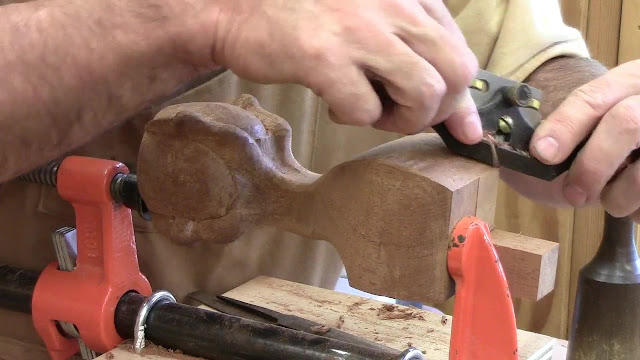I made a cardboard template to set the position of the tenon.
Then I positioned the template on the bottom of the chest and marked out where to drill the hole. I am going to use a 1 inch bit and then chop out the balance to square it up.
I used a 1 inch Forstner bit to drill the 1 1/2 inch deep hole in the bottom.
Chopping out the sides to make it square.
Paring to the line.
Test fit and it is nice and tight.
Gluing and clamping the feet to the chest, I sanded them to 150 grit before mounting.
This is a photo of the knee block that I took at the Yale Furniture Study. I made a cardboard template to use for the cutout of the knee block. You can see how much curve there has to be in both directions.
I cut out the face pattern on the band saw and then taped it back together. I positioned it on the leg and traced the curve on to the top of the block and traced the face of the curve on to the side.
I can only cut out the face curve on the band saw and will have to shape the second curve with files and rasps.
Here is the rough shape after bandsawing.
Here is the rough shape in place on the foot.
I use a pencil to trace the shape on the inside on the knee block. It needs to follow the shape of the leg.
As you can see the shape is almost a continuous curve. This is the shape I need to create with the rasps and files.
I put a screw in the back so I can clamp the block on my bench.
Following the pencil lines on the side I use the rasp and files to round over the block to match the curves.
This is about how it will look when I test fit using the practice foot. I am getting close to the final shape.
This test of the shape shows that I am just about complete. Still needs a little more clean up.
The side ones are much easier because they are only curved in one direction and can be band sawed near the final shape.
The original did not have mahogany blocks in the back. Just pine blocks which were not shaped.
That's it for now, I will glue them in place and do some final fitting to the feet.
Next will be the side cockbeading in the drawer openings.


























































